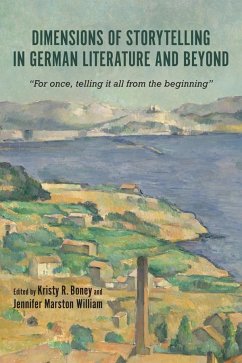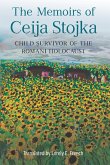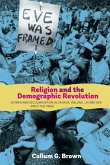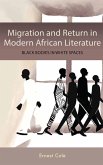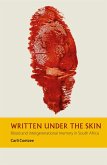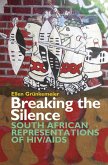Kristy Kristy Boney, Jennifer Marsto William, Amy Kepple Strawser, Andy Spencer, Benjamin RobinsonFor Once, Telling It All from the Beginning
Dimensions of Storytelling in German Literature and Beyond
For Once, Telling It All from the Beginning
Herausgeber: Kristy Boney, Kristy; William, Jennifer Marston
Kristy Kristy Boney, Jennifer Marsto William, Amy Kepple Strawser, Andy Spencer, Benjamin RobinsonFor Once, Telling It All from the Beginning
Dimensions of Storytelling in German Literature and Beyond
For Once, Telling It All from the Beginning
Herausgeber: Kristy Boney, Kristy; William, Jennifer Marston
- Gebundenes Buch
- Merkliste
- Auf die Merkliste
- Bewerten Bewerten
- Teilen
- Produkt teilen
- Produkterinnerung
- Produkterinnerung
Explores the storytelling of Anna Seghers and other 20th-century writers who faced the tensions between aesthetics and politically conscious writing, between conformity and resistance.
Andere Kunden interessierten sich auch für
![The Memoirs of Ceija Stojka, Child Survivor of the Romani Holocaust The Memoirs of Ceija Stojka, Child Survivor of the Romani Holocaust]() Ceija StojkaThe Memoirs of Ceija Stojka, Child Survivor of the Romani Holocaust127,99 €
Ceija StojkaThe Memoirs of Ceija Stojka, Child Survivor of the Romani Holocaust127,99 €![Religion and the Demographic Revolution Religion and the Demographic Revolution]() Callum G BrownReligion and the Demographic Revolution74,99 €
Callum G BrownReligion and the Demographic Revolution74,99 €![Women Medical Doctors in the United States Before the Civil War Women Medical Doctors in the United States Before the Civil War]() Edward C AtwaterWomen Medical Doctors in the United States Before the Civil War43,99 €
Edward C AtwaterWomen Medical Doctors in the United States Before the Civil War43,99 €![Migration and Return in Modern African Literature Migration and Return in Modern African Literature]() Ernest Ernest ColeMigration and Return in Modern African Literature117,99 €
Ernest Ernest ColeMigration and Return in Modern African Literature117,99 €![Written Under the Skin Written Under the Skin]() Carli CoetzeeWritten Under the Skin93,99 €
Carli CoetzeeWritten Under the Skin93,99 €![Female Circumcision and Clitoridectomy in the United States Female Circumcision and Clitoridectomy in the United States]() Sarah B M Webber RodriguezFemale Circumcision and Clitoridectomy in the United States127,99 €
Sarah B M Webber RodriguezFemale Circumcision and Clitoridectomy in the United States127,99 €![Breaking the Silence Breaking the Silence]() Ellen GrünkemeierBreaking the Silence117,99 €
Ellen GrünkemeierBreaking the Silence117,99 €-
-
-
Explores the storytelling of Anna Seghers and other 20th-century writers who faced the tensions between aesthetics and politically conscious writing, between conformity and resistance.
Produktdetails
- Produktdetails
- Verlag: Boydell & Brewer
- Seitenzahl: 290
- Erscheinungstermin: 20. Dezember 2018
- Englisch
- Abmessung: 152mm x 231mm x 23mm
- Gewicht: 612g
- ISBN-13: 9781640140400
- ISBN-10: 1640140409
- Artikelnr.: 53534809
- Herstellerkennzeichnung
- Libri GmbH
- Europaallee 1
- 36244 Bad Hersfeld
- gpsr@libri.de
- Verlag: Boydell & Brewer
- Seitenzahl: 290
- Erscheinungstermin: 20. Dezember 2018
- Englisch
- Abmessung: 152mm x 231mm x 23mm
- Gewicht: 612g
- ISBN-13: 9781640140400
- ISBN-10: 1640140409
- Artikelnr.: 53534809
- Herstellerkennzeichnung
- Libri GmbH
- Europaallee 1
- 36244 Bad Hersfeld
- gpsr@libri.de
Kristy R. Boney, Jennifer Marston William
Introduction: The Social, Political, and Personal Dimensions of
Storytelling - Kristy R. Boney and Jennifer Marston William PART I. ANNA
SEGHERS: A MISSING PIECE IN THE CANON OF MODERNIST STORYTELLERS Anna
Seghers in Heidelberg: The Formative Years - Christiane Zehl Romero Who Is
the Narrator? Anna Seghers's "The Excursion of the Dead Girls": Narrative
Mode and Cinematic Depiction - Peter Beicken Anna Seghers's Rubble
Literature, 1947-49 - Ute Brandes Anna Seghers and the Struggle to Tell
Stories about the Nazi Past in the Early German Democratic Republic -
Stephen Brockmann Aufbauzeit or flaue Zeit? Anna Seghers's GDR Novels -
Hunter Bivens The Time of Decision in Anna Seghers - Benjamin Robinson
Filling the Void with Stories: Anna Seghers's Conceptual Metaphors -
Jennifer Marston William PART II. EXPRESSIONS OF MODERNITY: USING
STORYTELLING UNCONVENTIONALLY Storytelling and Telling Stories in Heine's
Prose Fiction - Robert C. Holub Modernist Haze: Topographical Textures in
Paul Klee and Franz Kafka - Kristy R. Boney Synthesis and Transtextuality:
The Jewish Reinvention of Chinese Mythical Stories in "Shanghai Ghetto" -
Weijia Li American Children Writing Yiddish: The Published Anthologies of
the Chicago Sholem Aleichem Schools - Elizabeth Loentz A Literary Depiction
of the Homeland of Jews in Czechoslovakia and East Germany after 1945 -
Michaela Peroutkova Changed for the Better? Alternative Uses of the
Transformative Cancer Trope in Thomas Mann's Die Betrogene and Nadine
Gordimer's Get a Life - Kristen Hetrick PART III. THE PERSONAL NARRATIVE:
STORYTELLING IN ACUTE HISTORICAL MOMENTS Problems and Effects of
Autobiographical Storytelling: Als Pimpf in Polen: Erweiterte
Kinderlandverschickung 1940-1945 (1993) and A Hitler Youth in Poland: The
Nazis' Program for Evacuating Children during World War II (1998) - Jost
Hermand Too Near, Too Far: My GDR Story - Marc Silberman Conflict without
Resolution: Konrad Wolf and the Dilemma of Hatred - Andy Spencer "Bleibt
noch ein Lied zu singen": Autobiographical and Cultural Memory in Christa
Wolf's Novel Kindheitsmuster - Luke Springman Narrating Germany's Past: A
Story of Exile and the Return Home-A Translation of the Chapter "Above the
Lake" from Ursula Krechel's Novel Landgericht - Amy Kepple Strawser
Storytelling in the GDR: An Interview with Eberhard Aurich and Christa
Streiber-Aurich - Sylvia Fischer Notes on the Contributors
Storytelling - Kristy R. Boney and Jennifer Marston William PART I. ANNA
SEGHERS: A MISSING PIECE IN THE CANON OF MODERNIST STORYTELLERS Anna
Seghers in Heidelberg: The Formative Years - Christiane Zehl Romero Who Is
the Narrator? Anna Seghers's "The Excursion of the Dead Girls": Narrative
Mode and Cinematic Depiction - Peter Beicken Anna Seghers's Rubble
Literature, 1947-49 - Ute Brandes Anna Seghers and the Struggle to Tell
Stories about the Nazi Past in the Early German Democratic Republic -
Stephen Brockmann Aufbauzeit or flaue Zeit? Anna Seghers's GDR Novels -
Hunter Bivens The Time of Decision in Anna Seghers - Benjamin Robinson
Filling the Void with Stories: Anna Seghers's Conceptual Metaphors -
Jennifer Marston William PART II. EXPRESSIONS OF MODERNITY: USING
STORYTELLING UNCONVENTIONALLY Storytelling and Telling Stories in Heine's
Prose Fiction - Robert C. Holub Modernist Haze: Topographical Textures in
Paul Klee and Franz Kafka - Kristy R. Boney Synthesis and Transtextuality:
The Jewish Reinvention of Chinese Mythical Stories in "Shanghai Ghetto" -
Weijia Li American Children Writing Yiddish: The Published Anthologies of
the Chicago Sholem Aleichem Schools - Elizabeth Loentz A Literary Depiction
of the Homeland of Jews in Czechoslovakia and East Germany after 1945 -
Michaela Peroutkova Changed for the Better? Alternative Uses of the
Transformative Cancer Trope in Thomas Mann's Die Betrogene and Nadine
Gordimer's Get a Life - Kristen Hetrick PART III. THE PERSONAL NARRATIVE:
STORYTELLING IN ACUTE HISTORICAL MOMENTS Problems and Effects of
Autobiographical Storytelling: Als Pimpf in Polen: Erweiterte
Kinderlandverschickung 1940-1945 (1993) and A Hitler Youth in Poland: The
Nazis' Program for Evacuating Children during World War II (1998) - Jost
Hermand Too Near, Too Far: My GDR Story - Marc Silberman Conflict without
Resolution: Konrad Wolf and the Dilemma of Hatred - Andy Spencer "Bleibt
noch ein Lied zu singen": Autobiographical and Cultural Memory in Christa
Wolf's Novel Kindheitsmuster - Luke Springman Narrating Germany's Past: A
Story of Exile and the Return Home-A Translation of the Chapter "Above the
Lake" from Ursula Krechel's Novel Landgericht - Amy Kepple Strawser
Storytelling in the GDR: An Interview with Eberhard Aurich and Christa
Streiber-Aurich - Sylvia Fischer Notes on the Contributors
Introduction: The Social, Political, and Personal Dimensions of
Storytelling - Kristy R. Boney and Jennifer Marston William PART I. ANNA
SEGHERS: A MISSING PIECE IN THE CANON OF MODERNIST STORYTELLERS Anna
Seghers in Heidelberg: The Formative Years - Christiane Zehl Romero Who Is
the Narrator? Anna Seghers's "The Excursion of the Dead Girls": Narrative
Mode and Cinematic Depiction - Peter Beicken Anna Seghers's Rubble
Literature, 1947-49 - Ute Brandes Anna Seghers and the Struggle to Tell
Stories about the Nazi Past in the Early German Democratic Republic -
Stephen Brockmann Aufbauzeit or flaue Zeit? Anna Seghers's GDR Novels -
Hunter Bivens The Time of Decision in Anna Seghers - Benjamin Robinson
Filling the Void with Stories: Anna Seghers's Conceptual Metaphors -
Jennifer Marston William PART II. EXPRESSIONS OF MODERNITY: USING
STORYTELLING UNCONVENTIONALLY Storytelling and Telling Stories in Heine's
Prose Fiction - Robert C. Holub Modernist Haze: Topographical Textures in
Paul Klee and Franz Kafka - Kristy R. Boney Synthesis and Transtextuality:
The Jewish Reinvention of Chinese Mythical Stories in "Shanghai Ghetto" -
Weijia Li American Children Writing Yiddish: The Published Anthologies of
the Chicago Sholem Aleichem Schools - Elizabeth Loentz A Literary Depiction
of the Homeland of Jews in Czechoslovakia and East Germany after 1945 -
Michaela Peroutkova Changed for the Better? Alternative Uses of the
Transformative Cancer Trope in Thomas Mann's Die Betrogene and Nadine
Gordimer's Get a Life - Kristen Hetrick PART III. THE PERSONAL NARRATIVE:
STORYTELLING IN ACUTE HISTORICAL MOMENTS Problems and Effects of
Autobiographical Storytelling: Als Pimpf in Polen: Erweiterte
Kinderlandverschickung 1940-1945 (1993) and A Hitler Youth in Poland: The
Nazis' Program for Evacuating Children during World War II (1998) - Jost
Hermand Too Near, Too Far: My GDR Story - Marc Silberman Conflict without
Resolution: Konrad Wolf and the Dilemma of Hatred - Andy Spencer "Bleibt
noch ein Lied zu singen": Autobiographical and Cultural Memory in Christa
Wolf's Novel Kindheitsmuster - Luke Springman Narrating Germany's Past: A
Story of Exile and the Return Home-A Translation of the Chapter "Above the
Lake" from Ursula Krechel's Novel Landgericht - Amy Kepple Strawser
Storytelling in the GDR: An Interview with Eberhard Aurich and Christa
Streiber-Aurich - Sylvia Fischer Notes on the Contributors
Storytelling - Kristy R. Boney and Jennifer Marston William PART I. ANNA
SEGHERS: A MISSING PIECE IN THE CANON OF MODERNIST STORYTELLERS Anna
Seghers in Heidelberg: The Formative Years - Christiane Zehl Romero Who Is
the Narrator? Anna Seghers's "The Excursion of the Dead Girls": Narrative
Mode and Cinematic Depiction - Peter Beicken Anna Seghers's Rubble
Literature, 1947-49 - Ute Brandes Anna Seghers and the Struggle to Tell
Stories about the Nazi Past in the Early German Democratic Republic -
Stephen Brockmann Aufbauzeit or flaue Zeit? Anna Seghers's GDR Novels -
Hunter Bivens The Time of Decision in Anna Seghers - Benjamin Robinson
Filling the Void with Stories: Anna Seghers's Conceptual Metaphors -
Jennifer Marston William PART II. EXPRESSIONS OF MODERNITY: USING
STORYTELLING UNCONVENTIONALLY Storytelling and Telling Stories in Heine's
Prose Fiction - Robert C. Holub Modernist Haze: Topographical Textures in
Paul Klee and Franz Kafka - Kristy R. Boney Synthesis and Transtextuality:
The Jewish Reinvention of Chinese Mythical Stories in "Shanghai Ghetto" -
Weijia Li American Children Writing Yiddish: The Published Anthologies of
the Chicago Sholem Aleichem Schools - Elizabeth Loentz A Literary Depiction
of the Homeland of Jews in Czechoslovakia and East Germany after 1945 -
Michaela Peroutkova Changed for the Better? Alternative Uses of the
Transformative Cancer Trope in Thomas Mann's Die Betrogene and Nadine
Gordimer's Get a Life - Kristen Hetrick PART III. THE PERSONAL NARRATIVE:
STORYTELLING IN ACUTE HISTORICAL MOMENTS Problems and Effects of
Autobiographical Storytelling: Als Pimpf in Polen: Erweiterte
Kinderlandverschickung 1940-1945 (1993) and A Hitler Youth in Poland: The
Nazis' Program for Evacuating Children during World War II (1998) - Jost
Hermand Too Near, Too Far: My GDR Story - Marc Silberman Conflict without
Resolution: Konrad Wolf and the Dilemma of Hatred - Andy Spencer "Bleibt
noch ein Lied zu singen": Autobiographical and Cultural Memory in Christa
Wolf's Novel Kindheitsmuster - Luke Springman Narrating Germany's Past: A
Story of Exile and the Return Home-A Translation of the Chapter "Above the
Lake" from Ursula Krechel's Novel Landgericht - Amy Kepple Strawser
Storytelling in the GDR: An Interview with Eberhard Aurich and Christa
Streiber-Aurich - Sylvia Fischer Notes on the Contributors

